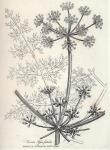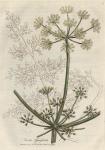
 Synonyma. Planta umbellifera, tripedalis, erecta, ramosa, glauca, flore luteo, Hope, Phil. Trans. vol. 75, p. 36.
Synonyma. Planta umbellifera, tripedalis, erecta, ramosa, glauca, flore luteo, Hope, Phil. Trans. vol. 75, p. 36.
Asafoetida umbellifera Levestico affinis, foliis instar Poeoniae ramosis; caule pleno maximo; semine foliaceo nudo solitario; Brancae ursinae vel pastinacas simili; radice asam foetidam fundente. Kaempfer Amoenit. Exot. p. 535. [Branca ursina is the Heracleum Sphondylium of Linnaeus.]
Gummi-resia, Asafoetida, Pharm. Lond. & Edin.
Hingiseh Persarum.
Altiht Arabum, et a quibusdam creditur (greek) vel (greek) Dioscor. Theophrast. Hippoc. &c.
Laer et Laserpitium, Latinorum.
Class Pentandria. Ord. Digynia. L. Gen. Plant. 343.
Ess. Gen. Ch. Fructus ovalis, compresso-planus, striis utrinque 3.
Spec. Char. F. Foliis alternatim sinuatis obtusis.
Linnaeus has given the specific character according to Kaempfer's representation of the Asafoetida plant, which differs in many respects from the figure here annexed, which is taken from that communicated to the Royal Society by the late Dr. Hope, and published in the 75th volume of the Philosophical Transactions: and this difference being so considerable as to indicate more than a mere botanical variety, Sir Joseph Banks thinks it probable that Asafoetida may be produced from different species of the ferula. Dr. Hope was undoubtedly the first who cultivated the Asafoetida plant in Britain, or perhaps in Europe, and his accurate description of it, as it grew in the botanical garden near Edinburgh, in the year 1784, is inserted below. [Planta umbellifera, tripedalis, erecta, ramosa, glauca, flore luteo.
Radix perennis.
Folia radicalia sex, procumbentia, trilobo-ovata, multoties pinnatim divisa; foliolis incisis, subacutis, subdecurrentibus; petiolo communi superne piano, linea elevata longitudinaliter per medium decurrente.
Caulis bipedalis, erectus, teretiusculus, annuus, leviter striatus, glaber, nudus praeter unam circa medium foliorum imperfectorum conjugationem; petiolo membranaceo concavo.
Rami nudi, patuli; quorum tres inferi, alterni, sustinentur singuli folii imperfecti petiolo membranaceo concavo. Quatuor intermedii verticillati sunt. Supremi ex apice caulis octo, quorum interni erecti. Omnes hi rami summitate sustinent umbellam compositam sessilem terminalem, et praeterea 3—6 ramulos externe positos, umbellas compositas ferentes. Hoc modo, rami inferiores sustinent 5, raro 6 ramulos; intermedii 3 vel 4; superiores 1 et 2.
Cal. Umbella universalis radiis 20—30 constat. Umbella partialis flosculis subsessilibus 10—20, Umbella composita sessilis convexo-plana. Umbella composita pedunculata haemispherica, Involucrum universale nullum. Involucrum partiale nullum. Perianthium proprium vix notabile.
Cor. universalis uniformis. Flosculi umbellae sessilis fertiles. Flosculi umbellae pedunculatae plerumque abortiunt. Cor. propria petalis quinque asqualibus, planis, ovatis: primo patulis, dein reflexis, apice ascendente.
Stam. Filamenta 5, subulata, corolla longiora, incurvata. Antherae subrotundae.
Pist. Germen turbinatum, inferum. Styli duo, reflexi. Stigmata apice incrassata.
Per. nullum: fruitus oblongus, piano-compressus, utrinque 3 lineis elevatis notatus est.
Sem. duo, oblonga, magna, utrinque plana, 3 lineis elevatis notata.
Planta odorem alliaceum diffundit. Folia, rami, pedunculi, radix, truncus, secti
succum fundunt lacteum, sapore et odore Asae foetidae.]
Though Asafoetida was formerly in great estimation both as a medicine and a fauce, yet we had no particular account of the plant till Kaempfer returned from his travels in Asia, and published his Amoenitates Exoticae in the beginning of the present century. As he saw the plant growing, and describes it from his own observation, we have collected the following general description from the history he has given:
It is a native of Persia, the root is perennial, tapering, ponderous, and increases to the size of a man's arm or leg, covered with a blackish coloured bark, and near the top beset with many strong rigid fibres; the internal substance is white, fleshy, and abounds with a thick milky juice, yielding an excessively strong fetid alliaceous smell; the stalk is simple, erect, straight, round, smooth, striated, herbaceous, about six or seven inches in circumference at the base, and rises luxuriantly to the height of two or three yards, or higher; [Caulis, in orgyjae, sesquiorgyjae, vel majorem longitudinem luxuriose exsurgens, crassite in imo quanta manus complexum superat.] radical leaves six or seven, near two feet long, bipinnated, pinnulae alternate, smooth, variously sinuated, lobed, and sometimes lance-shaped, of a deep green colour, and fetid smell; the umbels are compound, plano-convex, terminal, and consist of many radii: the seeds are oval, fiat, foliaceous, of a reddish brown colour, rough, marked with three longitudinal lines, have a porraceous smell, and a sharp bitter taste: the petals Kaempfer did not see, but supposes them in number five, minute, and white.
This plant is said to vary much according to the situation and soil in which it grows, not only in the shape of the leaves, but in the peculiar nauseous quality of the juice which impregnates them; this becomes so far altered that they are sometimes eaten by the goats.
Asafoetida is the concrete juice of the root of this plant, which is procured in the following manner on the mountains in the provinces of Chorasaan and Laar in Persia. At that season of the year when the leaves begin to decay, the oldest plants are selected [Radix quadriennio minor parum lactescit & nunquam secatur.] for this purpose. First the firm earth which encompasses the root, is rendered light by digging, and part of it cleared away, so as to leave a portion of the upper part of the root above the ground; the leaves and stalk are then twisted off and used with other vegetables for a covering to screen it from the sun, and upon this covering a stone is placed to prevent the winds from blowing it down; in this state the root is left for forty days, after which the covering is removed, and the top of the root cut off transversely; it is then screened again from the sun for forty-eight hours, which is thought a sufficient time for the juice to exude upon the wounded surface of the root, when the juice is scraped off by a proper instrument, and exposed to the sun to harden: this being done, a second transverse section of the root is made, but no thicker than is necessary to remove the remaining superficial concretions which would otherwise obstruct the farther effusion of fresh juice; the screening is then again employed for forty-eight hours, and the juice obtained a second time, as before mentioned. In this way the Asafoetida is eight times repeatedly collected from each root; observing, however, that after every third section, the root is always suffered to remain unmolested for eight or ten days, in order that it may recover a sufficient stock of juice. Thus, to exhaust one root of its juice, computing from the first time of collecting it to the last, a period of nearly six weeks is required; when the root is abandoned, and soon perishes.
The whole of this business is conducted by the peasants who live in the neighbourhood of the mountains where the drug is procured; and as they collect the juice from a number of roots at the same time, and expose it in one common place to harden, the sun soon gives it that consistence and appearance in which it is imported into Europe.
Asafoetida has a bitter, acrid, pungent taste, and is well known by its peculiar nauseous fetid smell, the strength of which is the surest tell of its goodness; this odour is extremely volatile, and of course the drug loses much of its efficacy by keeping. According to Kaempfer's account, the juice is infinitely more odorate when recent than when in the state brought to us: "Affirmare ausim, unam drachmam recens effusam, majorem spargere foetorem, quam centum libras vetustioris quem siccum venundant aromatarii nostrates." We have this drug in large irregular masses of a heterogeneous appearance, composed of various shining little lumps or grains, which are partly whitish, partly of a brownish or reddish, and partly of a violet hue. Those masses are accounted the best which are clear, of a pale reddish colour, and variegated with a great number of fine white tears. Asafoetida is composed of a gummy and a resinous substance, the first in largest quantity. Its smell and taste reside in the resin, which is readily dissolved and extracted by pure spirit, and, in a great part, along with the gummy matter, by water. [Lewis's Mat. Med.]"
Asafoetida is a medicine in very general use, and is certainly a more efficacious remedy than any of the other fetid gums: it is most commonly employed in hysteria, hypochondriasis, some symptoms of dyspepsia, flatulent colics, and in most of those diseases termed nervous: but its chief use is derived from its antispasmodic effects; and it is thought to be the most powerful remedy we possess for those peculiar convulsive and spasmodic affections which often recur in the first of these diseases, both taken into the stomach and in the way of enema. It is also recommended as an emmenagogue, anthelmintic, expectorant, [Dr. Cullen prefers it to the Gum Ammon as an expectorant. Asafoetida should therefore have a double advantage in spasmodic asthmas.] antiasthmatic, and anodyne. "Where we wish it to act immediately as an antispasmodic, it should be used in a fluid form, as that of tincture.
In the London Pharmacopoeia, a spirituous tincture of it is directed, and it is also an ingredient in the Pilulae e Gummi. In the Edinburgh Pharmacopoeia, Asafoetida is ordered in the Tinctura fuliginis, in the pilulae gummosae, and in the form of tincture with the Spt. Sal. ammon. vinos.

